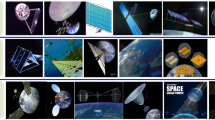Abstract
This paper presents the Power Plant Trio (PPT) Can Satellite (CanSat) platform developed by the University of Chosun, South Korea, with a focus on energy harvesting systems. The main objective of this project is to confirm the effectiveness of solar, wind and piezoelectric energy harvesting systems, which are utilized for LED lighting and activating a self-powered MEMS-based sensor module. The secondary objective of this project is to wirelessly transmit collected solar energy using the magnetic resonance method. To confirm compliance with the design requirements and to validate the effectiveness of the system, several pre-launch tests were conducted on-ground. The subsequent results of the CanSat flight test demonstrated that the proposed PPT CanSat system fulfills all of the required functions, satisfying the success criteria of the mission. The energy harvesting technologies introduced in this study can be effective for enhancing the power generation capability of spacecraft; in particular, for CubeSats with an extremely restricted size and available area for the installation of solar cells.

















Similar content being viewed by others
References
De Aragon AM (1998) Space applications of micro/nano-technologies. J Micromech Microeng 8(2):54–56
Vemal G, Lo C, Ong S, Lee BS, Yong CC (2009) MEMS vs. IC manufacturing: is integration between processes possible. In: 1st IEEE Asia Symposium on Quality Electronic Design, 15–16 July 2009, Kuala Lumpur, Malaysia
Rhee SH, Lyou J (2012) Development of a fine digital sun sensor for STSAT-2. Int J Aeronautic Space Sci 13(2):260–265
Youngner DW, Lu ST, Choueiri E, Neidert JB, Black III RE, Graham KJ, Fahey D, Lucus R, Zhu X (2000) MEMS mega-pixel micro-thruster arrays for small satellite staionkeeping. In: 14th Annual/USU Conference on Small Satellites, 21–24 August 2000 Logan, Utah
SwissCube RF Communications Description and ICD Documentation, http://www.goldstem.org/Swiss%20Cube/07%20-%20Telecommunications/S3-C-2-1-Swisscube%20RF%20communications%20description%20and%20ICD%2003-13-2008%20web.pdf
Kwon SC, Oh HU (2016) Experimental validation of satellite micro-management strategy in energy harvesting and vibration isolation. Sens Actuat 249:172–185
Makihara K, Onoda J, Minesugi K (2005) Low energy-consumption hybrid vibration suppression based on energy-recycling approach. AIAA J 43(8):1706–1715
Makihara K, Onoda J, Yabu T (2006) Novel approach to self-sensing actuation for semi-active vibration suppression. AIAA J 44(7):1445–1453
Makihara K, Onoda J, Minesugi K (2007) A self-sensing method for switching vibration suppression with a piezoelectric actuator. Smart Mater Struct 16(2):455–461
Park TY, Jung JY, Oh HU (2017) Experimental investigation on the feasibility of using a fresnel lens as a solar-energy collection system for enhancing on-orbit power generation performance. Int J Aerospace Eng 2017:1–13
Oh HU, Park TY (2015) Experimental feasibility study of concentrating photovoltaic power system for CubeSat applications. IEEE Trans Aerospace Electron Syst 51(3):1942–1949
Habraken S, Defise JM, Collette JP, Rochus P, D’Odemont PA, Hogge M (2001) Space solar arrays and concentrators. Acta Astronaut 48(5–12):421–429
Matunaga S, Yoshihara K, Sugiura Y, Sekiguchi M, Sawada H, Tsurumi S, Nakaya K, Mori M, Ui K, Maeda N, Mori O (2000) Titech micro-satellite model: CanSat for sub-obital flight. In: Proceedings of IEEE Aerospace Conference, 25–25 March 2000, Big Sky, Montana
Aly H, Sharkawy O, Nabil A, Yassin A, Tarek M, Amin SM, Ibrahim MK (2013) Project-based space engineering education: application to autonomous rover-back CanSat. In: 6th IEEE International Conference on Recent Advances in Space Technologies (RAST), 12–14 June 2013, Istanbul, Turkey
Kim HI, Kim JK, Choi JS, Kim SH, Oh HU (2019) Smartphone CanSat for actualization of real-time streaming video calls using remote screen touch system with shape memory alloy actuator. Trans Jpn Soc Aero Space Sci 62(5):256–264
Schilling K (2006) Design of pico-satellites for education in systems engineering. IEEE Aerosp Electron Syst Magazine 21(7):9–14
Nakasuka S (2000) Micro satellite and space education. J Space Technol Sci 16(1):1–8
Sako N, Tsuda Y, Ota S, Eishima T, Yamamoto T, Ikeda I, Ii H, Yamamoto H, Tanaka H, Tanaka A, Nakasuka S (2001) Cansat suborbital launch experiment-university educational space program using can sized pico-satellite. Acta Astronaut 48(5–12):767–776
Aydemır ME, Bensaada M, Fernando LHJDK, Akiyama H, Yamaura S (2011) Design and navigation control of an advanced level CANSAT. In: 5th International Conference on Recent Advances in Space Technologies, 9–11 June 2011, Istanbal, Turkey
Ümit ME, Cabanas W, Tetlow M, Akiyama H, Yamaura S, Olaleye S (2011) Development of a Fly-back CANSAT in 3 weeks, In: 5th IEEE International Conference on Recent Advances in Space Technologies (RAST), 9–11 June 2011, Istanbal, Turkey
Bohlouri V, Kosari AR, Aliha MRM (2014) Systematic design of an atmospheric data acquisition flying vehicle telemetry system. Eng Solid Mech 2(4):256–276
Colin A, Jimenez-Lizárraga M (2015) The CanSat technology for climate monitoring in small regions at altitudes below 1 km. In: IAA Climate Change and Disaster Management Conference, 17–17 September 2015, Mexico City, Mexico
Pande V, Paul J, Curillo M, Pallis JM (2014) Self sustaining solar powered cansat exploiting the power of the sun. In: American Society for Engineering Education (ASEE) Zone I Conference, 3–5 April 2014, Bridgeport, Connecticut
Space Technology Synthesis Laboratory, Chosun University. http://www.stslab.chosun.ac.kr/
Chae BG, Kim SH, Kim HI, Oh HU (2018) Development of P.P.T CanSat system applying energy harvesting system. J Korea Soc Aeronaut Space Sci 46(4):315–323 (Korean)
Mori M, Kagawa H, Saito Y (2006) Summary of studies on space power systems of Japan aerospace exploration agency. Acta Astronaut 59(1–5):132–139
Kurs A, Karalis A, Moffatt F, Joannopoulos JD, Fisher P, Soljacic M (2007) Wireless power transfer via strongly coupled magnetic resonance. Science 317:83–86
Lee MJ, Lee YK, Oh HU (2015) Performance evaluation of hinge driving separation nut-type holding and releasing mechanism triggered by nichrome burn wire. Int J Aeronautic Space Sci 16(4):602–613
Godson Technology. https://www.godsontechnology.com/
Acknowledgements
This research was supported by research fund from Chosun University (2021).
Author information
Authors and Affiliations
Corresponding author
Additional information
Publisher's Note
Springer Nature remains neutral with regard to jurisdictional claims in published maps and institutional affiliations.
Rights and permissions
About this article
Cite this article
Chae, BG., Oh, HU. Development of Power Plant Trio CanSat Platform Powered by Solar, Wind and Piezo Energy Harvesting Systems. Int. J. Aeronaut. Space Sci. 22, 1464–1480 (2021). https://doi.org/10.1007/s42405-021-00382-y
Received:
Revised:
Accepted:
Published:
Issue Date:
DOI: https://doi.org/10.1007/s42405-021-00382-y




